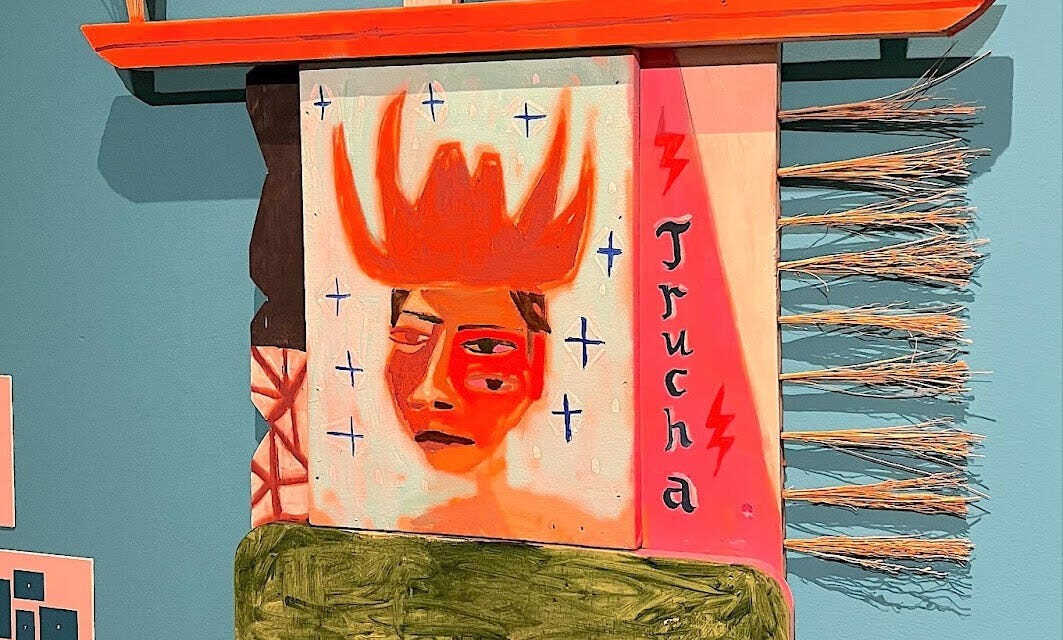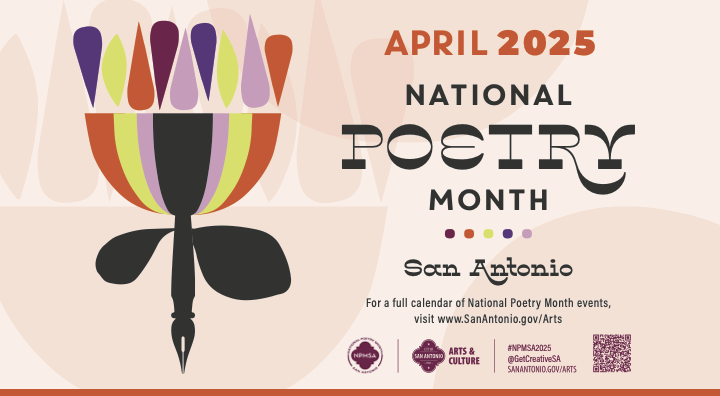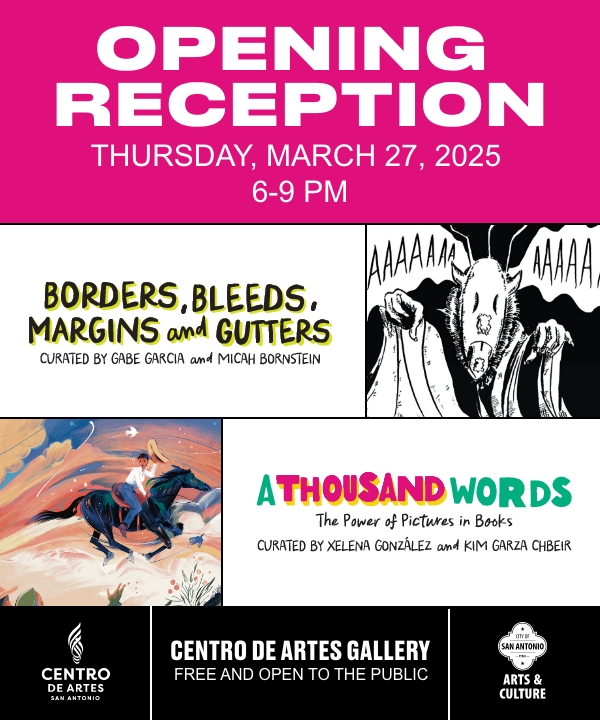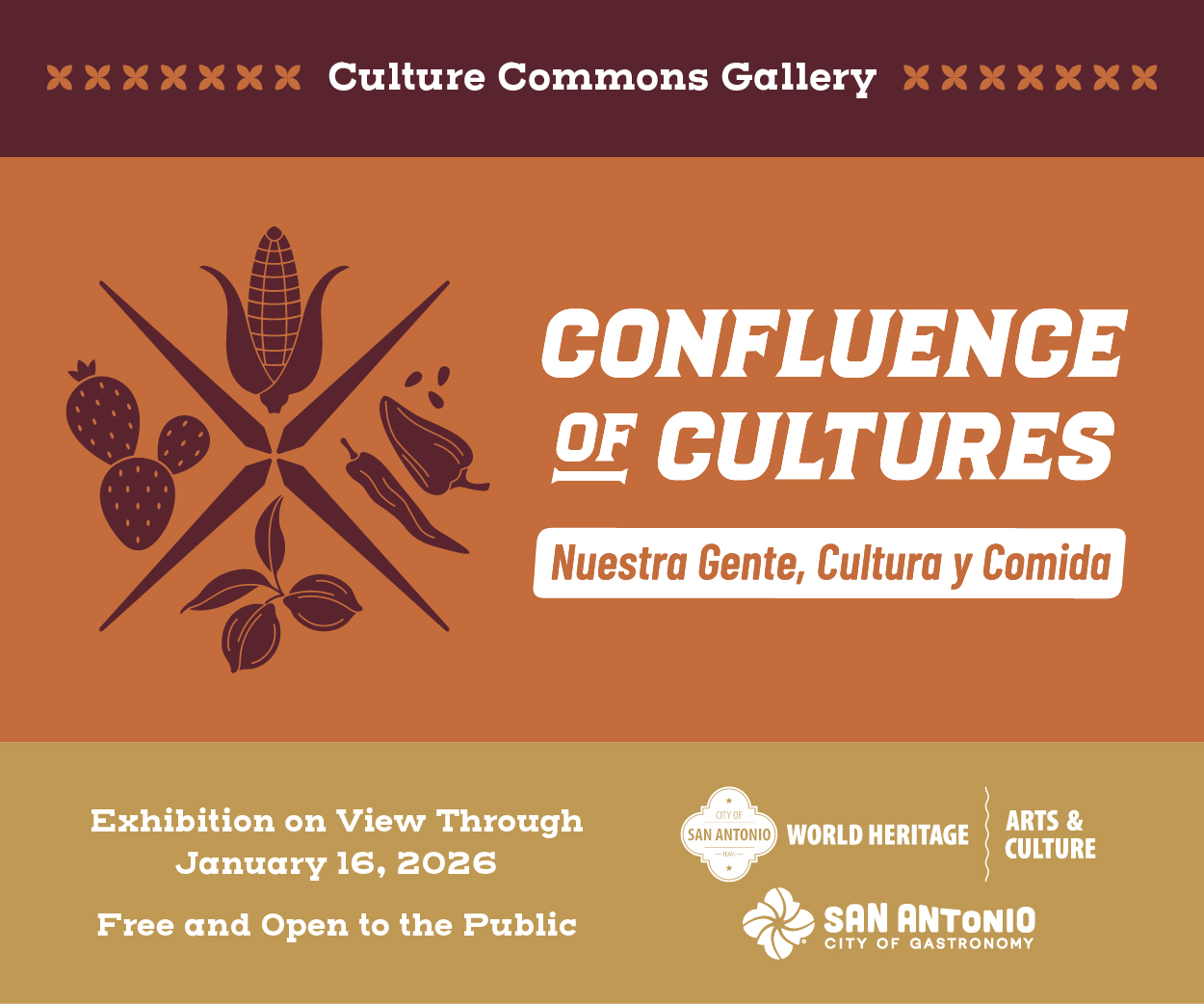The McNay Art Museum in San Antonio, Texas opened the Rasquachismo: 35 Years of a Chicano Sensibility exhibit in mid December 2024. McNay Latinx Art curator Mia Lopez and retired professor Tomás Ybarra-Frausto gave a tour of the exhibit in mid January. The tour began in the Octagon Gallery where a large work by Victoria Martinez hung from the ceiling. Martinez’s tapestry included hand painted cultural symbols on large squares of delicate fabric of different pastel colors. The artist used natural dyes from her environment.
Ybarra-Frausto, whose trail-blazing essay on rasquachismo inspired this exhibit, stood below the large colorfully embroidered panels that hung from the ceiling. He introduced rasquachismo “as playful, colorful, and layered with textures, blending high and low cultural elements in bold ways.” As we moved on to the two other major exhibition rooms which included 50 works of
art, he and Mia Lopez expanded on the meaning of rasquachismo.
Mia Lopez and her McNay colleagues have posted a definition of rasquachismo in the first exhibit room, which is a large space filled with paintings, photography, sculptures, textiles, and ceramic works. The McNay curators explained that artists featured in this gallery, “celebrate resourcefulness and creative problem-solving. In some instances, their work pays homage to the working class or highlights the material and aesthetics of labor.”
Chuck Ramirez [1962-2010], a San Antonio photographer is one of the artists in the exhibit most familiar to local visitors. A conceptual artist, Ramirez often focused on everyday objects and discarded items. His image of a household broom, an everyday object, is worn and tattered, and held together with cords of colorful woven string. Standing next to the Ramirez broom, Ybarra-Frausto expanded the term rasquachismo as “finding a way to transform everyday objects into artist expressions.”
I grew up in San Antonio’s Westside not far from Ybarra-Frausto’s home. When Ybarra-Frausto graduated from Brackenridge High School in 1956, there was plenty of rasquachismo in our working-class neighborhood. The make-do resourceful spirit of our barrio was evident in both homes and businesses. Ybarra-Frausto attended the University of Texas at Austin and graduated in 1960 with a degree in Spanish.
Ybarra-Frausto received a Master’s and doctoral degree from the University of Washington in Seattle, taught at Stanford University, served as the Associate
Director of Creativity and Culture at the Rockefeller Foundation for many years promoting arts and culture worldwide. In 2007, he was awarded the Smithsonian Institution’s Henry Medal, which recognizes individuals for service, achievements or contributions that add to the honor and growth of the Smithsonian. Mexico has awarded him the prestigious “Order of the Aztec Eagle” due to his life-long work nurturing a cultural understanding between the United States and Mexico by way of the arts and humanities.
Art critic Christopher Huerta linked the term rasquachismo to issues of identity and ethnic conflict. He explained, “The feeling of not being accepted as either Mexicans or Americans played a large role in driving Chicanos to create a self-identity that was so different from anything that had existed before.” He added “rasquachismo evolved as a response to the oppression faced by Chicanos and came to be the aesthetic of both a movement and of a people.”
I first became aware of aspects of rasquachismo when Harriett and I lived in Southern California in the late 1960s and 1970s. We volunteered for the United Farm Workers’s [UFW] Grape Boycott initiated by Cesar Chavez and Dolores Huerta. I also took students from my Upward Bound Program to visit the UFW headquarters in Delano and met with UFW artists and performers. Luis Valdez’s Teatro Campesino personified rasquache performances. The Teatro was hard-core rasquache in appearance and in language. They had many performances in Los Angeles and may have influenced artist groups such as ASCO which included Patssi Valdez whose work is included in the McNay exhibit.
During the McNay tour, Ybarra-Frausto explained that “Rasquachismo is neither an idea nor a style but more of an attitude or a taste.” Very generally, he added, it is an “underdog perspective–a view from los de abajo. An attitude rooted in resourcefulness and adaptability yet mindful of stance and style.” Several works by Juan de Dios Mora located on the first and second floor of the exhibit met Ybarra-Frausto’s “resourcefulness and adaptability” criteria. Mora grew up along the U.S.-Mexico border where he witnessed his neighbors fix their car washing machines, and lawnmowers by improvising rather than buying new parts. Their resourcefulness in making things work utilizing duck tape, clothes hanger wires, and discarded rubber products are evident in his drawings and prints.
Consuelo (Chelo) González Amezcua [1903-1975], an artist who painted on discarded cardboard, is the first and for nearly three decades the only Mexican American woman to exhibit at the McNay Art Museum. Amezcua was born in Piedras Negras, Mexico in 1903. In 1913, during the most violent years of the Mexican Revolution, her family immigrated to Del Rio, Texas where she lived the remainder of her life. Amezcua only attended school for six years and received no formal art training. In the 1930s, she was awarded a scholarship to attend San Carlos Academy in Mexico City but turned it down due to her father’s death.
González Amezcua’s solo exhibition came about through the efforts of San Antonio artist and socialite Amy Freeman Lee. Lee attended a dinner party in Del Rio in 1964 where she was captivated by Amezcua’s drawing hanging on the dining room wall. She learned about the Del Rio artist and became an enthusiastic supporter of her work. Lee introduced Amezcua’s work to McNay Art Museum curators and the cultural arts committee of the HemisFair 68. As a consequence of a McNay solo show and participation in HemisFair 68, her work gained the attention of the broader art world.
In 1970, art professor Jacinto Quirarte published a groundbreaking book, “Mexican American Artists” and selected a drawing by Amezcua for the cover. Quirarte commented that Amezcua drew on paper or reusable cardboard with ballpoint pens. Maria-Cristina Garcia [a former student of mine] wrote, “Her subjects are elaborately drawn, composed of tiny lines within curving patterns. They reveal her fascination with dreams and myths, as well as the dramatis personae of pre-Columbian history: gods, muses, and such royal personages as Cleopatra, the Náhuatl poet, King Netzahualcóyotl, birds, flowers, fanciful architecture, starry skies, hands” . Among her favorite motifs were beautiful women which she drew either as subjects or as backgrounds for works with historical or philosophical themes.
The McNay Museum collected early works by Amezcua, and also hosted a retrospective of work by Cesar Martinez in 1999. Jacinto Quirarte wrote an essay for that exhibition. Martinez noted, “Rasquachismo entered the realm of Chicano Art via a wonderful piece of writing by my friend of many years, Tomás Ybarra-Frausto. It is about the can-do, work-with-what-you-have spirit of the under classes to express themselves artistically.” Martinez added, “The term involved the use of discarded items, found materials and the like, to create artistic manifestations.”
The McNay’s Rasquachismo exhibit celebrates the Chicano aesthetic of finding beauty in everyday objects. The works include colorful assemblages by Victoria Martinez and Diana Molina, conceptual photography by Kathy Vargas, black and white prints by Juan de Dios Mora, and ceramic and woven pieces that incorporate “found objects” like bottle caps, different types of fabric, and pieces of bright beer can labels.
Tomás Ybarra-Frausto added posters, calendars, and other memorabilia from his personal collection of cultural “found objects” to the exhibit showcases. Mia Lopez’s
tenure at the McNay will encourage the inclusion of exciting new exhibits by drawing on her San Antonio roots and an extensive background of art history studies at prestigious institutions such as Rice University and the Art Institute of Chicago.










